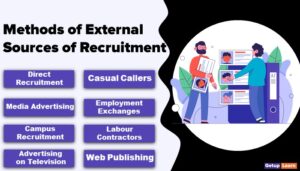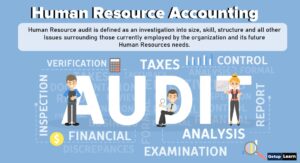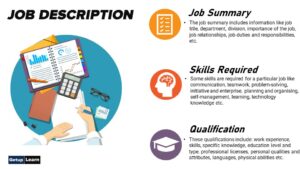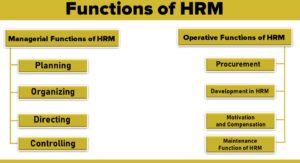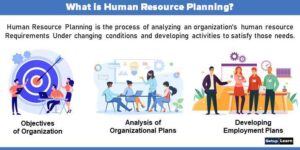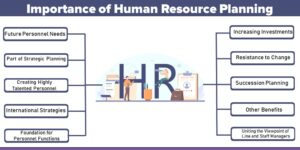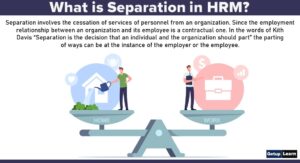Table of Contents
What is Job Design?
Job design is the specification of contents, methods, and relationships of a job in order to satisfy technological and organizational requirements as well as social and personal requirements of the job holder.

Through job design, a conscious effort is made to organize tasks, duties, and responsibilities into a unit of work to achieve certain objectives. There are three steps involved in the job design:
- Individual tasks have to be specified.
- The way in which these tasks have to be performed.
- The combination of tasks into specific jobs is to be undertaken and to whom those tasks are to be assigned is to be decided.
While designing a job, the interest of the organization regarding productivity, performance, and quality should be kept in mind. Further, employee satisfaction, the challenges that they may face as well as growth potential should also be kept in mind.
It should be ensured that simple language should be used while writing job design so that all stakeholders can easily understand it. The following are the various benefits of Job design:
- It enables the organization to develop employees who are efficient, dynamic, and responsive to any challenge faced by the organization.
- It ensures that the quality of goods and services is maintained.
- It eliminates the possibility of accidents as appropriate safety measures are taken.
- It helps in improving cooperation between the management and employees.
- It ensures that the employees are up to date in their skills which helps them in improving their careers.
Factors Affecting Job Design
The activity of Job Design is often influenced by many internal as well as external factors. The following are the factors affecting job design:
- Ergonomics
- Task Structure
- Task Assortment
- Level of Autonomy and Responsibility
- Practices
- Recognition and Support
- Technological Developments
- Strength of Union
- Corporate Culture
- Working Conditions

Ergonomics
The job which is to be designed should be according to the ability of the workers to avoid strain. The job design is influenced by who the present employees are in the organization. For this, the suitable weight and strength for the job have to be determined.
On the basis of this, the job is designed in such a manner that the physical requirement of the job does not exceed the physical condition of the employees.
Task Structure
Task structure is the manner in which the job is constructed and how the tasks are arranged in that job. The task structure influences the job design. They are identified through task objectives, criteria for entrance, the planned role of the job holder, and skills required. The job design is also influenced by materials, tools, technology, task process, quality, and performance evaluation tools.
Task Assortment
A job usually contains many tasks which enhance the interest of the job holder in performing such a job. The extent of how many tasks are involved influence the job design. But a job should not have too many varieties of jobs or too less variety of jobs. If more tasks are there, then it might be possible that the workers might be overburdened by work.
On the other hand, if fewer tasks are there then the workers might feel that the work is monotonous. The variety of work should be balanced which challenges the workers but does not give them stress.
Level of Autonomy and Responsibility
The level of freedom available to the employees also determined the job design. Generally, a job with a high rate of autonomy gives better satisfaction to employees. But such jobs usually carry a high degree of responsibility as well. Each employee should be made accountable for all decisions made by them while performing the job.
Practices
Practices are customs that have been developed over a period of time. They influence the way in which work is done in an organization. The working practices have to be incorporated into the new jobs that are designed. The job design, technology levels, and abilities of workers should be aligned for effective work performance.
Recognition and Support
The employees while doing their jobs expect some recognition and support from the management. This helps in building team spirit. Due to this reason, the job design process is influenced by the employee’s desire for recognition and support.
The job should be designed in such a manner that they allow the participation of employees in decisions making. They help in promoting a sense of belonging and high involvement.
Technological Developments
Technological development influences the way in which jobs are designed. When technology changes, the organization may have to redesign its jobs. It may lead to innovation in products or processes. Product innovations generally have a lesser impact on employee performance and job design. But process innovation leads to change in jib design as the skills of employees may have to be upgraded.
Strength of Union
In an organization where unions are present, job designing may not be done in an independent manner. The unions may influence the process of job design. For e.g. the unions may demand job security, influence the minimum skills requirements, or may demand high-quality tools and standard safety measures.
If these demands are not fulfilled, it might be possible, that the relationship between the union and the management may not be harmonious. As a result, the union’s attitude towards the job design process may not be positive and they may not cooperate with the management.
Corporate Culture
The corporate culture determines the response of the organization to the various changes in the external environment. Various factors such as labor market conditions, technological developments, etc reshape the corporate culture. Due to these changes, the corporate culture also changes.
The status, position, pay, and compensation are influenced by corporate culture. Job design is a way in which the organization communicates the corporate culture to the employees.
Working Conditions
While designing a job, the organization should take care that the jobs that are designed should offer a safe and healthy working environment to the employees. To ensure that employees continue to remain in the organization, the jobs that are designed should ensure that adequate safeguards are incorporated in the job design process.
Components of Job Design
The following are the major components of Job design:
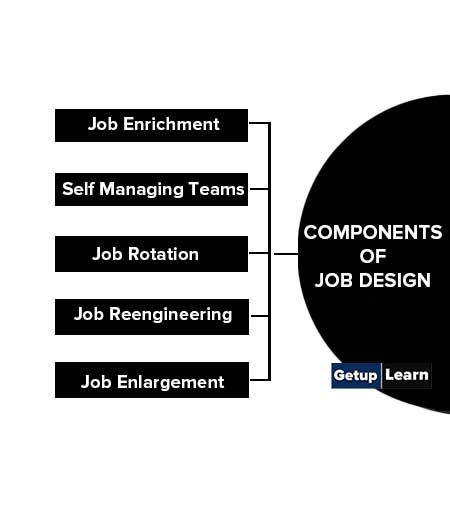
Job Enrichment
Job Enrichment refers to the development of work practices that motivate the employees to work in a better manner. Job enrichment ensures that Human Resources costs are reduced and employee satisfaction increases. In order to enrich jobs in an effective manner, the following points should be kept in mind:
- Encourage employees to involve themselves in goal setting and accomplishment of activities.
- Enhance the scope of the job to utilize the diverse skills of employees.
- Allow employees to do the whole job so that they could develop a sense of achievement.
- Provide adequate autonomy to employees.
- Make employees realize the contribution of their work towards the achievement of organization goals.
- Motivate employees to upgrade their skills and knowledge.
- Recognize and appreciate the effective performance of employees.
- Get constant feedback from the employees regarding their own performance by letting them know about the results of their own performance.
- Ensuring that employees believe that their present position in the organization is not the end of their career in the organization.
Self Managing Teams
These are such teams that are given full responsibility for the accomplishment of work or goals. All the decisions taken by them are autonomous. For ensuring success, accountability should be clearly defined. When group activities are involved, this method is suitable as it ensures that all employees are motivated as they have control of their own work.
To ensure that this method is successful the following things should be considered:
- Work Mapping
- Size of the team
- Leadership
- Rules and regulations
Job Rotation
It is an activity of moving employees from one job to another in a pre-decided manner. It helps the employees to assume diverse roles which gives them exposure to various jobs. Job rotation can take the form of promotion or it can be part of the training program for new employees. The following are the uses of Job rotation:
- It allows horizontal movement of employees which widens their knowledge and skills.
- The skills of employees can be developed through training.
- It increases the satisfaction of employees in job performance.
- It eliminates boredom associated with the performance of the job.
- It helps in the identification of latent talent of employees.
- It also helps in the career growth of employees.
Job Reengineering
It is the process of combining a few jobs into one, redistributing tasks among various jobs, and reallocation of resources for streamlining the jobs. It involves redesigning jobs and work systems to make the organization more competitive. For reengineering a job, the below process is followed:
- Breaking the Pattern
- Realigning with corporate goals
- Abolition of the Power structure
- Redesign flow of work
- Redefine titles and positions
- Promote learning in the organization
- Incentives and Rewards based on Performance.
Job Enlargement
Through Job enlargement, more or different tasks are included in the jobs. This is done to make the job more attractive. For this, it has to be ensured that the interest and needs of employees and management are fulfilled. Job enlargement can take two forms:
-
Horizontal enlargement: In horizontal enlargement, the job includes the enlargement of duties by adding new but similar tasks. It aims at developing new skills in employees. It is generally adopted when the tasks are complex and structured. The percentage of contribution of employees towards achievement of organizational goals increases.
- Vertical Enlargement: Vertical enlargement involves enlargement in the extent of freedom which is allowed an employee to decide how the task is to be done. It allows the employee to get involved in planning, organizing, and controlling. It reduces restrictions on employees but increases authority and accountability. Through vertical enlargement, the status of employees is alleviated. This method is suitable where the tasks involved are routine and well structured.
Limitations of Job Design
Through job design may improve the overall productivity and performance, the program of job design is many times is met with many limitations of job design which are as under:
- The employees resisted the job design programs as job enrichment activities made the jobs more challenging and resulted in more mistakes and lapses.
- Job enrichment is necessary not to follow job title enrichment as well.
- It is also possible that trade unions may oppose job design programs as they fear that it might result in the loss of jobs.
- Job design techniques require the managers to spend time with the employees to make them understand the implications of the process. It might be possible that managers may not be very keen to spare their time to spend with workers.
- Job design may be opposed by employees who lack inter-personnel skills as there is a possibility that they would be forced to work in teams.
- The employees may resist it because it may result in reduced freedom.
- Frequently, the job design programs may leave employees mentally tired due to the stress of increased responsibility. This may lead to increase absenteeism.
- Many times companies feel that the cost of job design outweighs its benefits.
What is the meaning of job design?
Job design is the specification of contents, methods, and relationships of a job in order to satisfy technological and organizational requirements as well as social and personal requirements of the job holder.
What are the factors affecting job design?
These are the factors affecting job design:
1. Ergonomics
2. Task Structure
3. Task Assortment
4. Level of Autonomy and Responsibility
5. Practices
6. Recognition and Support
7. Technological Developments
8. Strength of Union
9. Corporate Culture
10. Working Conditions etc.
What are the four components of job design?
Following are the components of job design:
1. Job Enrichment
2. Self-Managing Teams
3. Job Rotation
4. Job Reengineering
5. Job Enlargement etc.


